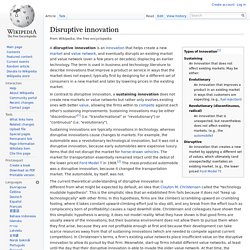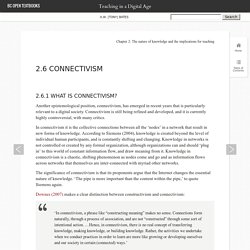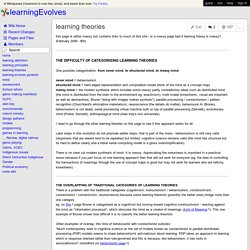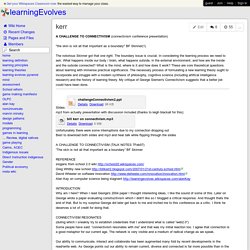

LittleBoxes. Disruptive innovation. Sustaining innovations are typically innovations in technology, whereas disruptive innovations cause changes to markets.

For example, the automobile was a revolutionary technological innovation, but it was not a disruptive innovation, because early automobiles were expensive luxury items that did not disrupt the market for horse-drawn vehicles. The market for transportation essentially remained intact until the debut of the lower priced Ford Model T in 1908. The mass-produced automobile was a disruptive innovation, because it changed the transportation market.
The automobile, by itself, was not. The current theoretical understanding of disruptive innovation is different from what might be expected by default, an idea that Clayton M. The work of Christensen and others during the 2000s has addressed the question of what firms can do to avoid displacement brought on by technological disruption. History and usage of the term[edit] The term disruptive technologies was coined by Clayton M. What Is Disruptive Innovation? The theory of disruptive innovation, introduced in these pages in 1995, has proved to be a powerful way of thinking about innovation-driven growth.

Many leaders of small, entrepreneurial companies praise it as their guiding star; so do many executives at large, well-established organizations, including Intel, Southern New Hampshire University, and Salesforce.com. Unfortunately, disruption theory is in danger of becoming a victim of its own success. Despite broad dissemination, the theory’s core concepts have been widely misunderstood and its basic tenets frequently misapplied.
Furthermore, essential refinements in the theory over the past 20 years appear to have been overshadowed by the popularity of the initial formulation. As a result, the theory is sometimes criticized for shortcomings that have already been addressed. There’s another troubling concern: In our experience, too many people who speak of “disruption” have not read a serious book or article on the subject. 1. 2. 3. 4. Connectivism in Learning Activity Design: Implications for Pedagogically-Based Technology Adoption in African Higher Education Contexts. Volume 17, Number 2 February - 2016 Rita Ndagire Kizito Nelson Mandela Metropolitan University, Port Elizabeth, South Africa This paper examines the possible characteristics and the value of designing learning activities grounded in connectivism—an emerging learning theory.

It is an exploratory attempt to connect the theory to the prevailing technology adoption archetypes used in African contexts with the aim of extracting influences that could shape pedagogical technology adoption in African higher education contexts. What Connectivism Is. Posted to the Connectivism Conference forum (which hits a login window - click 'login as guest' (middle of the left-hand column) - I'm sorry, and I have already complained to the conference organizer).

At its heart, connectivism is the thesis that knowledge is distributed across a network of connections, and therefore that learning consists of the ability to construct and traverse those networks. It shares with some other theories a core proposition, that knowledge is not acquired, as though it were a thing. Hence people see a relation between connectivism and constructivism or active learning (to name a couple).
Constructivism%20and%20Connectivism%20in%20Education%20Technology. Teaching in a Digital Age. 2.6.1 What is connectivism?

Another epistemological position, connectivism, has emerged in recent years that is particularly relevant to a digital society. Connectivism is still being refined and developed, and it is currently highly controversial, with many critics. In connectivism it is the collective connections between all the ‘nodes’ in a network that result in new forms of knowledge. According to Siemens (2004), knowledge is created beyond the level of individual human participants, and is constantly shifting and changing. Knowledge in networks is not controlled or created by any formal organization, although organizations can and should ‘plug in’ to this world of constant information flow, and draw meaning from it. Group items tagged connectivism - EDTECH at Boise State University. Sokolovskaya MA S2015. Connectivism hand out. LearningEvolves - learning theories. This page is rather messy but contains links to much of this site - is a messy page bad if learning theory is messy?

(February 2009 - Bill) LearningEvolves - kerr. A CHALLENGE TO CONNECTIVISM (connectivism conference presentation) "the skin is not all that important as a boundary" BF Skinner(1) The notorious Skinner got that one right.

The boundary issue is crucial. In considering the learning process we need to ask: What happens inside our body / brain, what happens outside, in the external environment, and how are the inside and the outside connected? What is the mind, where is it and how does it work? These are core theoretical questions about learning with immense practical significance. The necessary process of formulating a new learning theory ought to incorporate and struggle with a modern synthesis of philosophy, cognitive science (including artifical intelligence research) and the history of learning theory.
Slides: mp3 from actually presentation with discussion included (thanks to leigh blackall for this): "An artificial radical discontinuity is manufactured" yes I like that view. Bell Connectivism Its place in theory informed research. Clara Learning online MOOC connectivism and. Downes Places to Go Connectivism Connective Knowledge. Revenscroft Dialogue and Connectivism. Siemens 2005 Connectivism A learning theory for the digital age. Siemens Connectivism Design and Delivery.